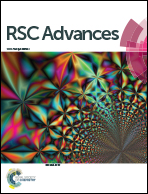Graphene oxide/vinyl ester resin nanocomposite: the effect of graphene oxide, curing kinetics, modeling, mechanical properties and thermal stability
Abstract
Graphene oxide (GO) was synthesized and nanocomposites were prepared using different contents of the GO and vinyl ester resin (VE). The suspension was sonicated in order to prevent agglomeration. The non-isothermal differential scanning calorimetry (DSC) technique was used to study the cure kinetics of neat VE and 0.3 wt% GO/VE nanocomposite. Kissinger and Ozawa equations were used to determine the activation energy (Ea). The Ea values of the cured GO/VE nanocomposite showed a decrease with respect to the neat VE. It is concluded that GO has a catalytic effect in the cure reaction. The dynamic curing process was modeled to predict the degree of curing and curing rate of resin. The modeling results showed a good agreement between the experimental data and model for different heating rates (5, 10, 15 and 20 °C min−1). The glass transition temperature (Tg) was obtained from the maximum peak temperature of the loss factor curve. The Tg was increased by nearly 10 °C by the addition of 0.4 wt% GO to VE. Tensile mechanical tests were studied and the nanocomposite of 0.3 wt% GO/VE showed higher elongation and tensile strength. This percent (0.3 wt% GO/VE) was selected for non-isothermal differential scanning calorimetry (DSC) to study the cure kinetics. Scanning electron microscopy (SEM) was studied to discern the surface features and dispersion of GO. The thermal stability of the cured VE and its nanocomposite was investigated with thermogravimetric analysis (TGA). The char yields increased with the addition of 0.3, 1.5, and 3 wt% of GO to the vinyl ester resin. The addition of GO improved the polymer flame retardancy and thermal resistance.


 Please wait while we load your content...
Please wait while we load your content...